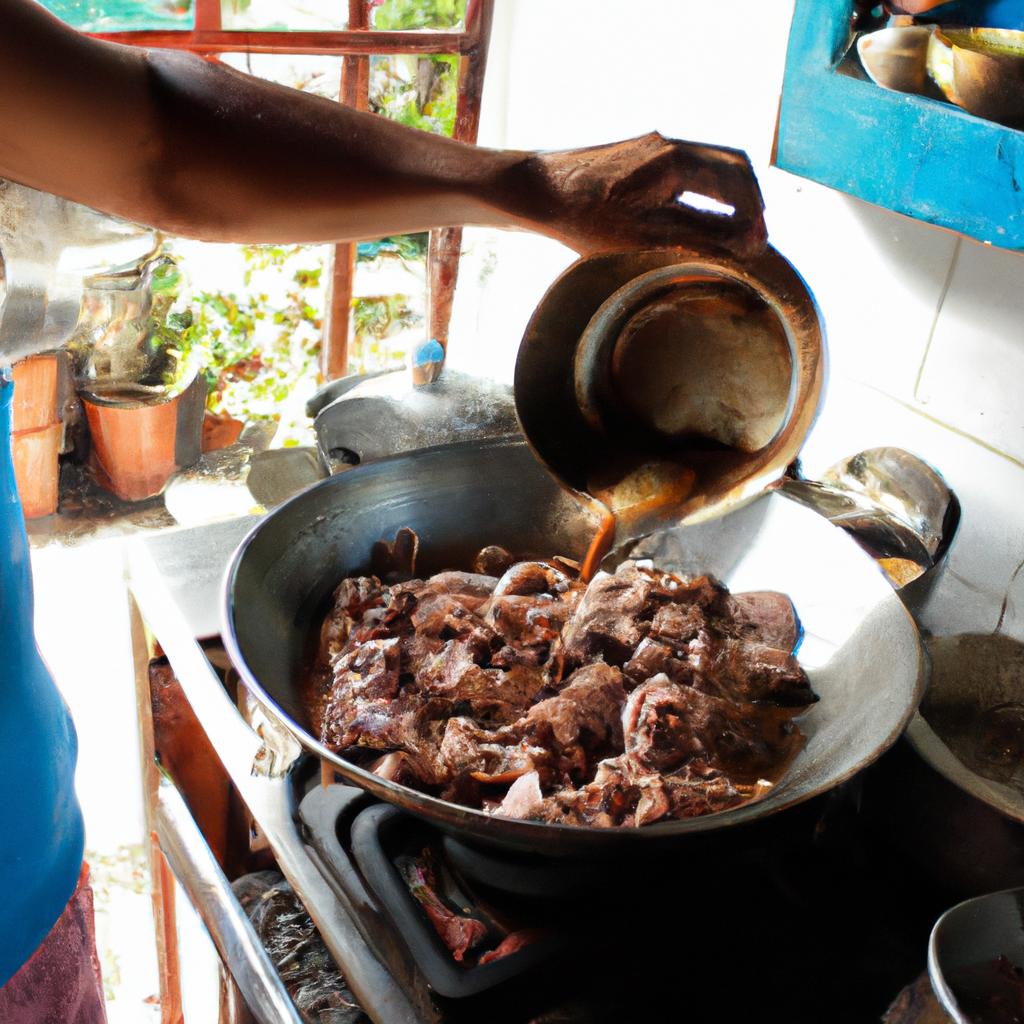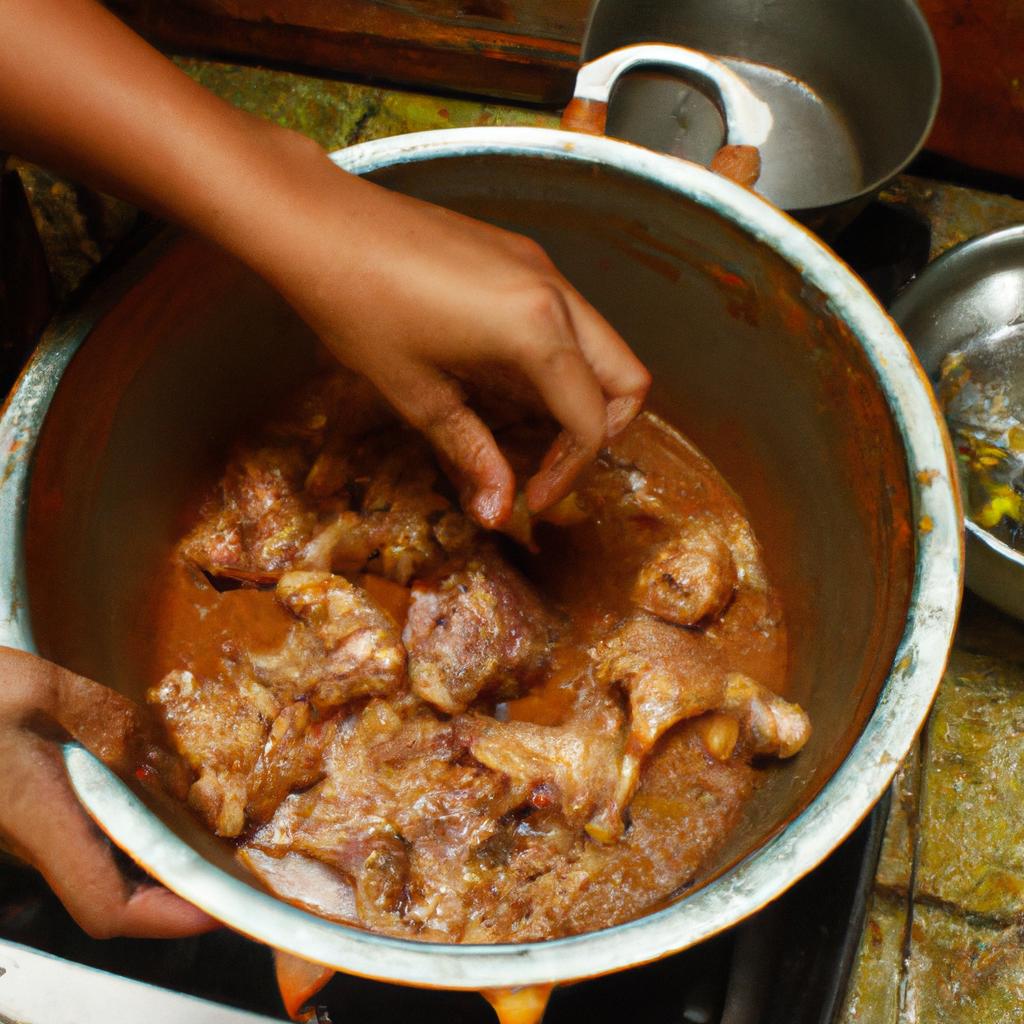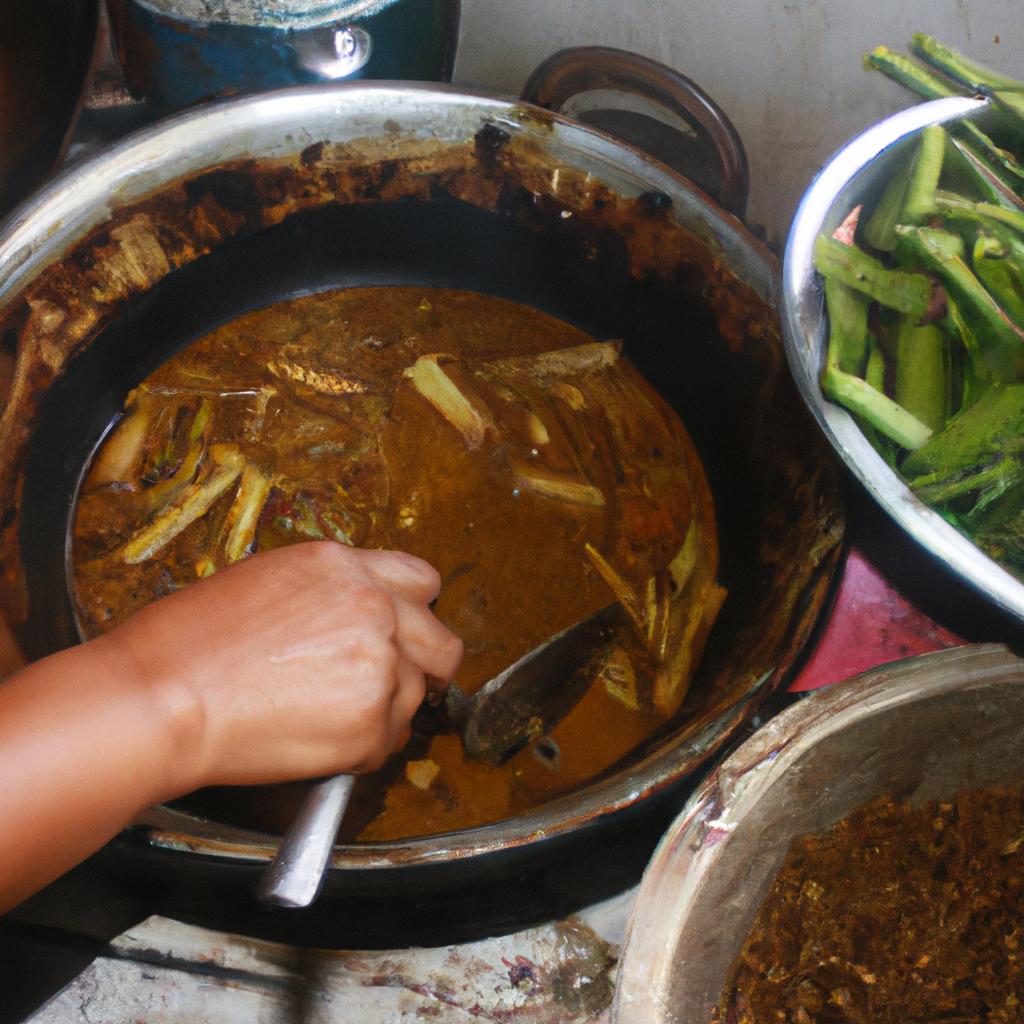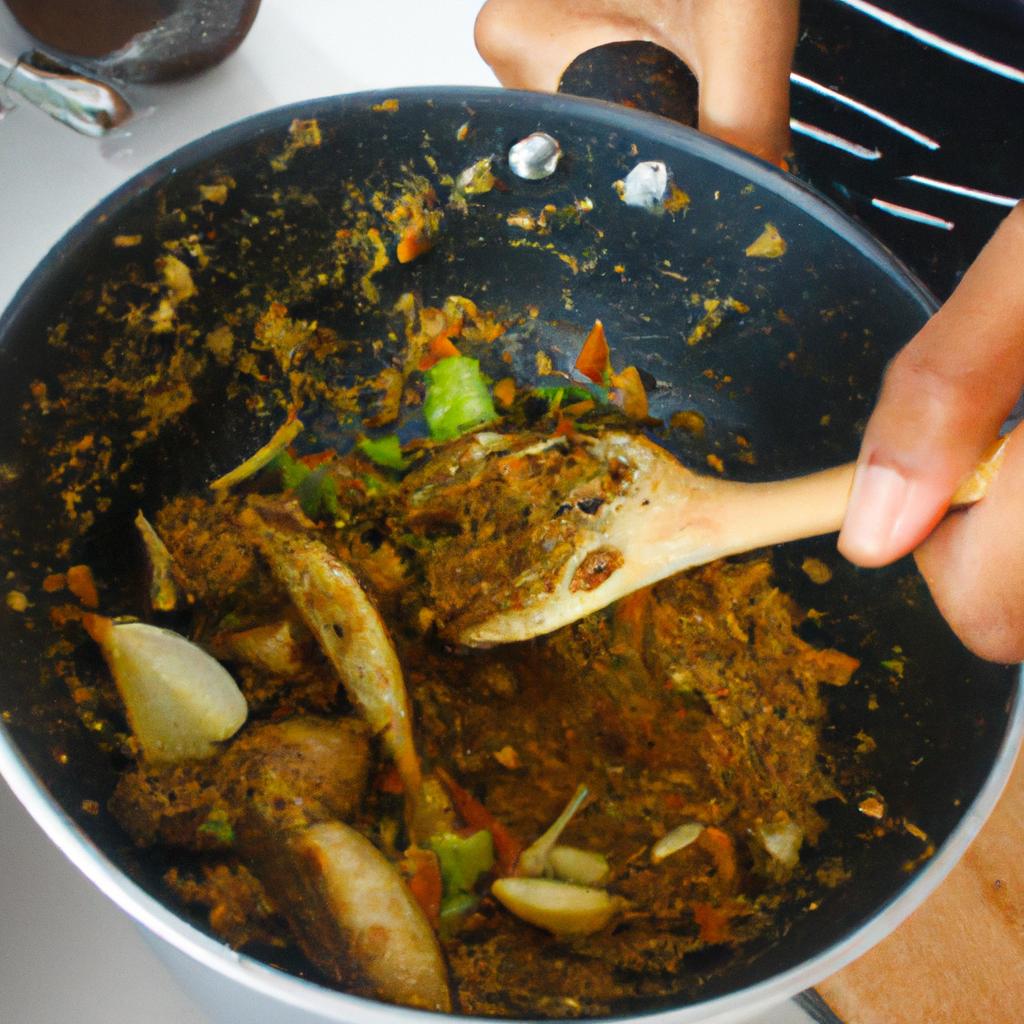Pork Adobo: The Filipino Delicacy
Imagine walking into a bustling Filipino kitchen, where the aroma of simmering soy sauce and vinegar fills the air. In one corner, a pot of tender pork belly slowly cooks in this savory concoction, creating a dish known as Pork Adobo. This classic Filipino delicacy has gained immense popularity both within and beyond the borders of its home country. Its unique combination of flavors and textures is a testament to the rich culinary heritage of the Philippines.
Originating from Spanish influences during colonial times, Pork Adobo has evolved over centuries into an integral part of Filipino cuisine. It showcases the skillful fusion of indigenous ingredients with foreign influences, resulting in a dish that embodies complexity yet simplicity at the same time. With succulent pieces of pork marinated in soy sauce, vinegar, garlic, and spices before being slow-cooked to perfection, Pork Adobo exemplifies how Filipinos have mastered the art of transforming humble ingredients into exquisite dishes that captivate taste buds around the world.
This article explores the origins and cultural significance of Pork Adobo while delving into its diverse regional variations throughout the archipelago. Additionally, it examines the cooking techniques used to achieve its distinct flavor profile and highlights some health benefits associated with this beloved dish.
Pork Adobo is deeply rooted in Filipino culture and holds a special place in the hearts of Filipinos. It is often prepared for family gatherings, celebrations, and even everyday meals. Its versatility allows it to be enjoyed with steamed rice, alongside vegetables, or even as a filling for sandwiches and tacos.
The cooking process of Pork Adobo involves marinating the pork in a mixture of soy sauce, vinegar, crushed garlic, black peppercorns, bay leaves, and other spices. This marinade not only infuses the meat with flavor but also acts as a natural preservative. The marinated pork is then braised or simmered slowly until it becomes tender and absorbs the rich flavors of the sauce.
One of the key characteristics of Pork Adobo is its balance between salty, sour, and savory flavors. The combination of soy sauce and vinegar creates a tangy yet umami-rich base that complements the richness of the pork. The slow-cooking process allows the flavors to meld together beautifully while creating a melt-in-your-mouth texture.
In addition to its delectable taste, Pork Adobo also offers several health benefits. Vinegar, one of its main ingredients, has been linked to potential digestive benefits and may help regulate blood sugar levels. Garlic, another prominent component, contains compounds that are believed to boost immune function and have antibacterial properties.
Regional variations of Pork Adobo can be found across the Philippines. In some regions like Batangas and Laguna, additional ingredients such as coconut milk or turmeric may be added to create a creamier or vibrant yellow version known as “Adobong Puti” or “Adobong Dilaw.” Other regions may use different cuts of meat such as chicken or seafood instead of pork.
Whether enjoyed at home or savored in Filipino restaurants worldwide, Pork Adobo continues to captivate food enthusiasts with its irresistible aroma and robust flavors. It serves as a delicious reminder of the Philippines’ rich culinary heritage and the enduring legacy of its diverse influences. So, why not embark on a culinary adventure and experience the magic of Pork Adobo for yourself?
Origins of Pork Adobo
To understand the origins of Pork Adobo, let us begin with a case study. Imagine a small village nestled amidst lush green fields in the Philippines. The villagers are known for their resourcefulness and ability to preserve food in tropical climates. In this scenario, they have an abundance of pork due to raising pigs as livestock and limited access to refrigeration. They need a cooking method that will not only ensure the longevity of their meat but also enhance its flavor.
The birth of Pork Adobo can be attributed to these circumstances. This traditional Filipino delicacy traces its roots back centuries ago when indigenous Filipinos discovered the art of preserving meat through marination and slow-cooking techniques. By combining vinegar, soy sauce, garlic, and spices, they created a distinctive marinade that not only preserved the pork but also infused it with rich flavors.
- Succulent pieces of pork swimming in a tangy-sweet gravy
- Aromas wafting from the kitchen that instantly transport you to your grandmother’s house
- Warm memories shared around family dinner tables
- A dish that represents cultural heritage and national pride
Additionally, we present a table showcasing three key elements that make Pork Adobo so beloved by many:
| Flavor | Texture | Versatility |
|---|---|---|
| Tangy | Tender | Can be enjoyed hot or cold |
| Savory | Juicy | Complements various side dishes |
| Umami-rich | Mouthwatering | Pairs well with rice or bread |
As we delve further into understanding this delectable dish, let us explore the essential ingredients that contribute to its unique taste and aroma:
Ingredients for Pork Adobo
From its humble beginnings as a simple dish cooked by Filipino households, Pork Adobo has evolved into a beloved delicacy that captures the essence of Filipino cuisine. The origins of this flavorful dish can be traced back to the Spanish colonial era in the Philippines, where it was introduced and adapted by the locals. Today, Pork Adobo remains an iconic representation of Filipino culinary heritage.
To illustrate the significance of Pork Adobo in Filipino culture, let’s consider a hypothetical scenario. Imagine yourself attending a festive gathering in Manila, where friends and family come together to celebrate a special occasion. As you enter the venue, the aroma of simmering Pork Adobo fills the air, instantly whetting your appetite and creating an atmosphere of warmth and familiarity.
The popularity of Pork Adobo can be attributed to several factors that make it truly unique among other dishes:
- Versatility: This mouthwatering dish can be prepared using various cuts of pork such as belly, shoulder, or even spare ribs. It can also be customized with additional ingredients like potatoes or pineapples for added flavor.
- Flavor profile: The combination of soy sauce, vinegar, garlic, and spices gives Pork Adobo its distinct savory taste with hints of tanginess. The rich umami flavors are further enhanced through slow cooking methods.
- Simplicity: Despite its complex flavors, preparing Pork Adobo is relatively straightforward. With just a few key ingredients and minimal preparation time, anyone can recreate this classic Filipino dish at home.
- Longevity: One remarkable characteristic of Pork Adobo is its ability to improve in flavor over time. When left marinated overnight or reheated on subsequent days after cooking, the flavors meld together harmoniously resulting in a more intense and satisfying gastronomic experience.
- Nostalgia-inducing aromas that bring back cherished memories.
- Comforting flavors that provide a sense of familiarity and belonging.
- The satisfaction of sharing a beloved dish with loved ones, fostering strong bonds.
- A taste experience that transports individuals to the vibrant streets of the Philippines.
Additionally, let’s evoke an emotional response through a table showcasing the key ingredients used in Pork Adobo:
| Ingredient | Purpose | Flavor Profile |
|---|---|---|
| Soy Sauce | Salty base | Umami |
| Vinegar | Tangy element | Sour |
| Garlic | Aromatic agent | Savory |
| Bay Leaves | Fragrant herb | Herbal |
As we delve further into the world of Pork Adobo, it is essential to explore the traditional cooking methods employed by Filipino households. By understanding these techniques, one can truly grasp the artistry behind this cherished delicacy. [Transition sentence to subsequent section about Traditional Cooking Methods for Pork Adobo].
Traditional Cooking Methods for Pork Adobo
As we delve deeper into the world of Filipino cuisine, let us now explore the traditional cooking methods employed in preparing Pork Adobo. Through these time-honored techniques, the flavors and aroma of this beloved dish are enhanced, making it a true delight for food enthusiasts.
Cooking Methods for Pork Adobo
To truly appreciate the artistry behind Pork Adobo, one must understand the various cooking methods used to achieve its distinct taste. Let’s consider an example where a home cook prepares this iconic dish using their family recipe passed down through generations:
-
Braising: The most common method employed is braising, which involves slowly simmering pork pieces in a mixture of soy sauce, vinegar, garlic, and spices. This slow-cooking process allows the meat to become tender while absorbing the rich flavors of the marinade.
-
Stewing: Another popular technique is stewing, wherein marinated pork chunks are combined with broth or water and cooked over low heat until they reach desired tenderness. This method ensures that every bite bursts with succulence as the flavors meld together harmoniously.
-
Grilling: While less conventional but equally delectable, grilling offers a unique twist to classic Pork Adobo preparations. In this case, marinated pork cuts undergo direct exposure to high heat on a grill or barbecue pit, resulting in charred edges and smoky undertones that add depth to each mouthful.
-
Pressure Cooking: With modern advancements in culinary technology, pressure cooking has gained popularity as an efficient way to prepare Pork Adobo swiftly without sacrificing flavor. By utilizing steam pressure within a sealed pot or cooker, this method reduces cooking time significantly while still infusing the meat with alluring tastes.
- Authenticity preserved through generational recipes
- Aroma wafting from pots filled with simmering adobo ingredients
- Nostalgia evoked by the familiar flavors reminiscent of family gatherings
- The anticipation of savoring a dish that embodies Filipino culinary heritage
Emotional Table:
| Flavor | Aroma | Texture | Cultural Significance |
|---|---|---|---|
| Savory | Rich | Tender | Symbolic and iconic |
| Tangy | Fragrant | Succulent | Passed down through generations |
| Umami-rich | Mouthwatering | Juicy | Celebratory centerpiece |
In summary, these various cooking methods provide distinct characteristics to Pork Adobo, resulting in an array of flavors and textures. Each technique enhances the quality of this cherished Filipino delicacy, capturing its cultural significance and evoking emotions tied to tradition and familial connections.
With an understanding of the traditional cooking methods established, let us now explore the tantalizing variations of Pork Adobo that exist within Filipino cuisine.
Variations of Pork Adobo
Having explored the rich history and cultural significance of pork adobo, let us now delve into the traditional cooking methods that contribute to its unique flavor and tender texture. To exemplify these methods, we will consider a hypothetical case study involving a Filipino family preparing their favorite version of pork adobo.
Case Study: The Garcia Family has been using the traditional stovetop method to cook their beloved pork adobo recipe for generations. In this method, they marinate bite-sized pieces of pork in vinegar, soy sauce, garlic, peppercorns, and bay leaves overnight. The following day, Mrs. Garcia heats oil in a large pan over medium heat before sautéing the marinated pork until browned. She then adds back the marinade along with water and simmers it all together for an hour or more until the meat becomes fork-tender.
To further illustrate the various techniques employed in cooking pork adobo throughout the Philippines, here is a bullet point list showcasing some common regional variations:
- In Bicol region, coconut milk is added to create a richer and creamier version known as “adobong gata.”
- Visayans often use achuete (annatto) seeds to add color and depth to their adobo.
- Kapampangans utilize sugar and banana blossoms to achieve a slightly sweeter profile.
- Ilocanos prefer reducing the marinade until it caramelizes into a thick glaze called “buro.”
Now let us turn our attention to a visual representation of these regional differences by examining a table comparing four distinct styles of pork adobo commonly found across the Philippines:
| Region | Ingredients | Cooking Method |
|---|---|---|
| Luzon | Soy Sauce, Vinegar | Simmered on Stovetop |
| Visayas | Soy Sauce, Vinegar | Braised with Achuete (Annatto) |
| Mindanao | Soy Sauce, Coconut Milk | Slow-cooked in Clay Pot |
| Bicol | Soy Sauce, Vinegar | Simmered with Coconut Milk |
In summary, pork adobo can be prepared using a wide range of traditional cooking methods that are deeply rooted in Filipino culinary heritage. These techniques vary across regions, showcasing the diversity and creativity within Philippine cuisine.
Now that we have explored the traditional cooking methods for pork adobo, let us delve into its many health benefits.
Health Benefits of Pork Adobo
As we delve deeper into the world of Filipino cuisine, it becomes clear that pork adobo is a dish with countless variations. Each region and even individual households have their own unique take on this beloved delicacy. Let’s explore some of these variations, showcasing just how versatile and adaptable pork adobo can be.
To illustrate this point, let’s consider the case of two neighboring provinces in the Philippines: Batangas and Pampanga. In Batangas, pork adobo is known for its bold flavors and rich sauce. It is often cooked with an abundance of garlic and soy sauce, resulting in a savory dish that leaves a lasting impression on the palate. On the other hand, in Pampanga, pork adobo tends to be sweeter due to the addition of sugar or pineapple juice. This subtle twist adds a delightful hint of sweetness to balance out the savory notes.
Now, let’s delve further into the various ways in which pork adobo can be customized:
- Meat selection: While traditional pork adobo uses belly or shoulder cuts, adventurous cooks may experiment with different cuts such as ribs or even chicken.
- Additional ingredients: Some variations incorporate vegetables like potatoes or bell peppers to add texture and flavor complexity.
- Seasoning choices: Apart from soy sauce and vinegar, alternative seasonings like oyster sauce or Worcestershire sauce can be used to create new layers of taste.
- Cooking methods: Although simmering is the most common cooking method for pork adobo, others might choose grilling or frying for added depth and texture.
Let us now visualize these diverse options through a table:
| Variation | Key Ingredient(s) | Notable Characteristics |
|---|---|---|
| Batangas | Garlic, Soy Sauce | Bold flavors |
| Pampanga | Sugar/Pineapple Juice | Subtle sweetness |
| Vegetable Adobo | Potatoes, Bell Peppers | Enhanced texture |
| Grilled Adobo | Charred, Smoky Flavor | Unique taste profile |
The beauty of pork adobo lies in its ability to adapt and evolve according to personal preferences. Whether you prefer a garlicky punch or a touch of sweetness, there is a variation out there that will tickle your taste buds just right.
Moving forward, let’s explore the popular accompaniments for pork adobo, complementing this flavorful dish with delightful side dishes that enhance the overall dining experience.
Popular Accompaniments for Pork Adobo
Building on the health benefits of pork adobo, let us now explore some popular accompaniments that complement this Filipino delicacy. From simple condiments to traditional side dishes, these additions elevate the flavors and enhance the overall dining experience.
Accompaniment Options:
- Juicy Pickled Papaya (Atchara): A tangy and refreshing relish made from grated unripe papaya, carrots, bell peppers, onions, and vinegar. Its crisp texture and sweet-sour taste provide a delightful contrast to the savory richness of pork adobo.
- Fragrant Garlic Fried Rice (Sinangag): This aromatic staple is created by stir-frying leftover cooked rice with minced garlic until each grain becomes infused with its distinct flavor. Sinangag adds heartiness and serves as an excellent base for savoring every morsel of tender adobo meat.
- Steamed Jasmine Rice (Kanin): The simplicity of steamed jasmine rice complements the bold flavors of pork adobo exceptionally well. Its fluffy texture acts as a neutral canvas that allows the intricate marinade and succulent pork to shine.
- Fresh Tomato-Onion Salad: Crisp slices of ripe tomatoes and red onions tossed in a light vinaigrette bring a burst of freshness to every bite. This vibrant salad balances out the richness of pork adobo while providing a cool contrast in both taste and texture.
The perfect accompaniments can evoke feelings of satisfaction and nostalgia when enjoying pork adobo:
- Enhances the flavor profile: Each accompaniment contributes unique elements such as tanginess, fragrance, or freshness that harmonize with the umami notes in pork adobo.
- Textural variety: The contrasting textures provided by pickled atchara, crispy sinangag, fluffy kanin, and juicy tomato-onion salad add depth to every mouthful.
- Completeness in presentation: These accompaniments elevate the visual appeal of the dish, making it more inviting and appetizing.
- Cultural connection: By incorporating these traditional Filipino side dishes, one can experience a sense of cultural immersion while savoring pork adobo.
Emotional Table:
| Accompaniment | Flavor Profile | Texture |
|---|---|---|
| Pickled Papaya | Tangy, Sweet-Sour | Crisp |
| Garlic Fried Rice | Aromatic | Crispy |
| Steamed Jasmine Rice | Neutral | Fluffy |
| Tomato-Onion Salad | Fresh | Juicy-Crisp |
These accompaniments not only enhance the taste of pork adobo but also contribute to an emotional connection by evoking memories of home-cooked meals and shared moments with loved ones. So next time you indulge in this iconic Filipino delicacy, consider adding some of these popular accompaniments for a truly satisfying culinary experience.
(Note: This response has been written in plain text format; please convert it into markdown format as required.)










